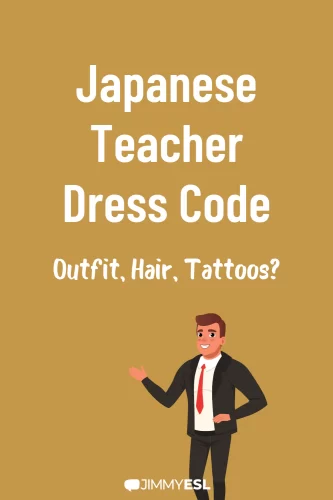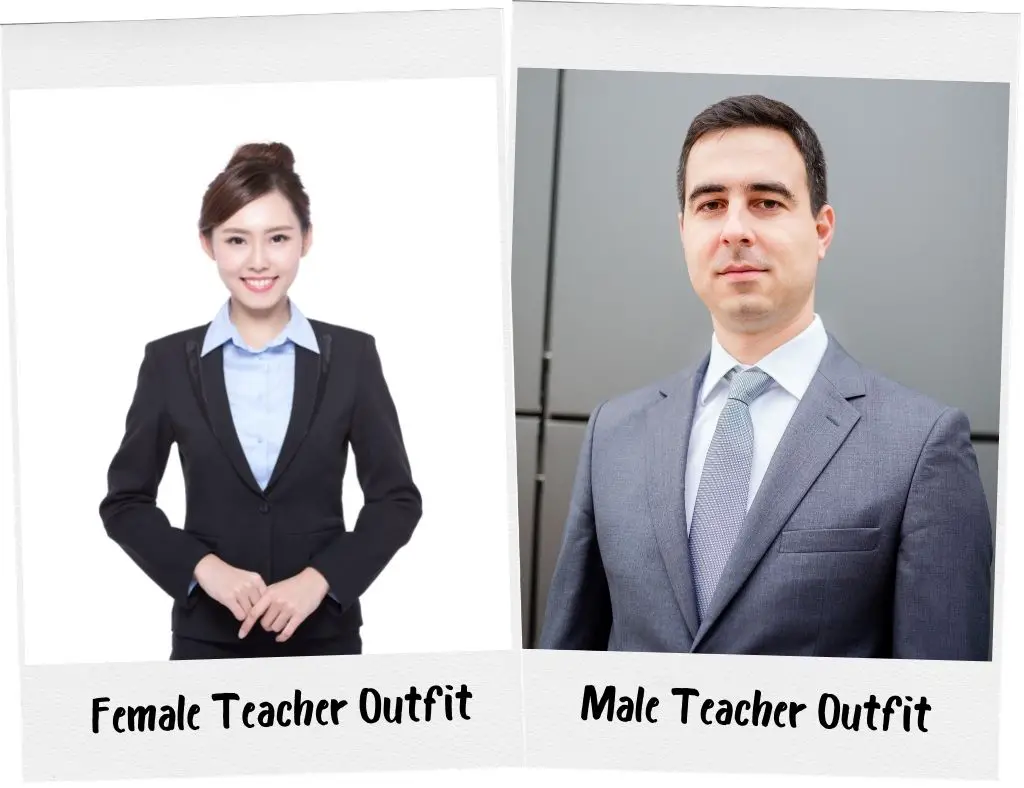Clothes make the man, the saying goes. (And the women, of course.) That’s especially true when you are a teacher in a very formal and conservative country like Japan.
Are you going to teach English (ESL) or another subject in a Japanese school and want to know what to wear? Do you need to dress in a full business suite (or even uniform)? And what about long hair or tattoos?
In this post, I’ll explain the Japanese teacher dress code and touch upon the various Dos and Don’ts.
Join our mailing list to receive a free ESL teaching resource every week.

Dress Code for Teachers in Japan
The dress code for ESL teachers in Japan is “business professional” to “business casual.”
There are a few different options for where you can teach English in Japan. They are:
- Public Schools
- Private Language Schools
- Corporate Training Schools
In Japan, the expectations for a teacher’s attire is very conservative. The private language and corporate training schools have a business professional dress code, while public schools can range from business professional to business casual.
Outfits for Female Teachers
When there is some flexibility with other types of clothing, female teachers should avoid wearing sleeveless shirts or anything low cut that shows cleavage. Shirts that button high up at the neck are the best.
Japanese culture requires that you bow, so showing even a hint of cleavage in these moments would not be culturally acceptable. The shoulders should be covered. Pants or knee-length or longer dresses are suitable, though jeans are not. Your clothes should not be tight-fitting. Blazers can be worn on top of your outfit to give you a professional appearance.
All clothing should be in subtle tones without being too vibrant.
Outfits for Male Teachers
It is quite common that your school will require you to wear a suit and tie. Otherwise, men can wear trousers, button-up dress shirts or collared shirts, either short or long-sleeved.

Prints on Clothes
Be mindful of images and messages printed on your clothes, especially when it comes to politics, religion, profanity, and sex. You should be respectful of Japanese culture and norms as well as command respect from your students, parents, and school administrators.
Shoes
You will need a pair of indoor shoes or slippers to wear while you are at school, which should not be open-toed, sandals, or sneakers.
Everyday Dresses vs. Special Occasions
When thinking about what to wear, also think about your comfort. You will likely be animated when teaching, so you’ll want to wear clothing that allows you to move around comfortably.
You will also want to have more formal attire for business luncheons or ceremonial functions.
Clothes for the Different Seasons
Japan’s weather and climate feature four distinct seasons:
- Spring, from March to May, is pleasantly warm with little rain.
- In summer, from June to August, there is heavy rainfall and extreme humidity. Northern regions tend to be a bit cooler.
- Autumn, from September to November, is commonly fair.
- Winter from December to February can be snowy and quite cold.
Japan also experiences a typhoon season, which occurs from May to October, peaking in August and September. Typhoons bring strong winds, torrential rain, and hazardous winds.
So, you should plan for the seasons when shopping for clothes.
Hair
Men’s hair should be nicely styled and cut short. Some schools may allow men to have long hair provided it is clean and tidy.
For women, the length of hair isn’t an issue. You can have it long or short, worn up or down, although it should be clean and tidy no matter which style you choose.
Dyed hair, other than your natural color, is not likely to be allowed.
Facial hair
Facial hair is acceptable in most schools in Japan; however, make sure you keep it neat and trimmed to maintain a professional look.
Makeup
It is generally not appropriate for women to wear makeup except for just the lightest mascara, lip gloss, or pale lipstick. Perfume and nail polish are not acceptable. Men should not wear makeup or perfume.
Tattoos
Tattoos are generally taboo at any Japanese school, and if visible, should be covered up at all times, either by clothing or makeup.
Jewelry
In general, earrings and piercings are acceptable in most schools; however, large or excessive jewelry may be considered inappropriate.
Buying XXL clothing in Japan
It may be hard to find extra-large sized clothing or footwear, so it’s best to carry some with you if you have difficulty finding these once you are there.
Dress Conservatively at the Beginning
Every workplace is different, so it’s best to dress conservatively during the first few days, paying attention to what other teachers are wearing and then adjusting accordingly. Maybe, it will be okay to “downgrade“ slowly over time.
Read our dress code guide for teachers in Korea.
Why Do Teachers Wear Tracksuits in Japan?
After reading this article, this question might seem totally out of place.
But yes, it’s true, especially in public primary schools you see teachers wearing full tracksuits. The reason is, that they have more physical work, taking care of the children, having outside activities or giving gym classes, for example.
In her blog, a teacher reports that she even spotted a “terribly attractive combo of button-up shirt and tie with track pants on a vice-principal“. Many young students wear tracksuits, too.
However, in any other type of school or training center in Japan (above primary), the teacher dress code is formal, like explained above.